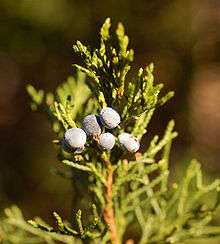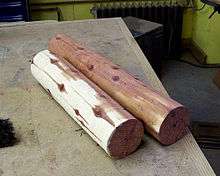Juniperus virginiana
| Juniperus virginiana | |
|---|---|
| | |
| Juniperus virginiana incorporated into a golf course in northern Virginia | |
| Scientific classification | |
| Kingdom: | Plantae |
| Division: | Pinophyta |
| Class: | Pinopsida |
| Order: | Pinales |
| Family: | Cupressaceae |
| Genus: | Juniperus |
| Species: | J. virginiana |
| Binomial name | |
| Juniperus virginiana L. | |
 | |
| Natural distribution of varieties virginiana (green) and silicicola (red) | |
Juniperus virginiana — its common names include red cedar, eastern redcedar,[2][3] Virginian juniper,[4] eastern juniper, red juniper, pencil cedar, and aromatic cedar — is a species of juniper native to eastern North America from southeastern Canada to the Gulf of Mexico and east of the Great Plains.[3] Further west it is replaced by the related Juniperus scopulorum (Rocky Mountain juniper) and to the southwest by Juniperus ashei (Ashe juniper).[5][6][7]
Description

Juniperus virginiana is a dense slow-growing coniferous evergreen tree that may never become more than a bush on poor soil, but is ordinarily from 5–20 m or 16–66 ft tall, with a short trunk 30–100 cm or 12–39 inches in diameter (rarely to 27 m or 89 ft in diameter, and 170 cm or 67 inches tall). The oldest tree reported, from West Virginia, was 940 years old.[8][9] The bark is reddish-brown, fibrous, and peels off in narrow strips. The leaves are of two types; sharp, spreading needle-like juvenile leaves 5–10 mm (3⁄16–3⁄8 in) long, and tightly adpressed scale-like adult leaves 2–4 mm (1⁄16–3⁄16 in) long; they are arranged in opposite decussate pairs or occasionally whorls of three. The juvenile leaves are found on young plants up to 3 years old, and as scattered shoots on adult trees, usually in shade. The seed cones are 3–7 mm (1⁄8–1⁄4 in) long, berry-like, dark purple-blue with a white wax cover giving an overall sky-blue color (though the wax often rubs off); they contain one to three (rarely up to four) seeds, and are mature in 6–8 months from pollination. The juniper berry is an important winter food for many birds, which disperse the wingless seeds. The pollen cones are 2–3 mm (1⁄16–1⁄8 in) long and 1.5 mm (1⁄16 in) broad, shedding pollen in late winter or early spring. The trees are usually dioecious, with pollen and seed cones on separate trees.[5][6][7]
There are two varieties,[2] which intergrade where they meet:[5][6][7]
- Juniperus virginiana var. virginiana is called eastern juniper / redcedar. It is found in eastern North America, from Maine, west to southern Ontario and South Dakota, south to northernmost Florida and southwest into the post oak savannah of east-central Texas. Cones are larger, 4–7 mm (3⁄16–1⁄4 in); scale leaves are acute at apex and bark is red-brown.
- Juniperus virginiana var. silicicola (Small) E.Murray (syn. Sabina silicicola Small, Juniperus silicicola (Small) L.H.Bailey) is known as southern or sand juniper / redcedar. Habitat is along the Atlantic and Gulf coasts from the extreme Southeastern corner of Virginia,[10] south to central Florida and west to southeast Texas. Cones are smaller, 3–4 mm (1⁄8–3⁄16 in); scale leaves are blunt at apex and the bark is orange-brown. It is treated by some authors at the lower rank of variety, while others treat it as a distinct species.
Ecology

Eastern juniper is a pioneer species, which means that it is one of the first trees to repopulate cleared, eroded, or otherwise damaged land. It is unusually long lived among pioneer species, with the potential to live over 900 years. It is commonly found in prairies or oak barrens, old pastures, or limestone hills, often along highways and near recent construction sites.[5][6][11] It is an alternate host for cedar–apple rust, an economically significant fungal disease of apples, and some management strategies recommend the removal of J. virginiana near apple orchards[12]
In many areas it is considered an invasive species, even if native. It is fire-intolerant, and was previously controlled by periodic wildfires. Low branches near the ground burn and provide a ladder that allows fire to engulf the whole tree. Grasses recover quickly from low severity fires that are characteristic of prairies that kept the trees at bay. With the urbanization of prairies, the fires have been stopped with roads, plowed fields, and other fire breaks, allowing J. virginiana and other trees to invade.[13] Trees are destructive to grasslands if left unchecked, and are actively being eliminated by cutting and prescribed burning.[14] The trees also burn very readily, and dense populations were blamed for the rapid spread of wildfires in drought stricken Oklahoma and Texas in 2005 and 2006.[15]
Eastern juniper benefits from increased CO2 levels, unlike the grasses with which it competes. Many grasses are C4 plants that concentrate CO2 levels in their bundle sheaths to increase the efficiency of RuBisCO, the enzyme responsible for photosynthesis, while junipers are C3 plants that rely on (and may benefit from) the natural CO2 concentrations of the environment, although they are less efficient at fixing CO2 in general.[16]
Damage done by J. virginiana includes outcompeting forage species in pastureland. The low branches and wide base occupy a significant portion of land area. The thick foliage blocks out most light, so few plants can live under the canopy. The needles that fall raise the pH of the soil, making it alkaline, which holds nutrients such as phosphorus, making it harder for plants to absorb them. Juniperus virginiana has been shown to remove nitrogen from the soil after invading prairies.[17] It has also been found to reduce carbon stores in the soil. This reduction in soil nutrients also reduces the amount and diversity of microbial activity in the soil.[18]
Cedar waxwings are fond of the "berries" of these junipers. It takes about 12 minutes for their seeds to pass through the birds' guts, and seeds that have been consumed by this bird have levels of germination roughly three times higher than those of seeds the birds did not eat. Many other birds (from bluebirds to turkeys) and many mammals also consume them.[11]
Uses

The fine-grained, soft brittle pinkish- to brownish-red heartwood is fragrant, very light and very durable, even in contact with soil. Because of its rot resistance, the wood is used for fence posts. The aromatic wood is avoided by moths, so it is in demand as lining for clothes chests and closets, often referred to as cedar closets and cedar chests. If correctly prepared, it makes excellent English longbows, flatbows, and Native American sinew-backed bows. The wood is marketed as "eastern redcedar" or "aromatic cedar". The best portions of the heartwood are one of the few woods good for making pencils, but the supply had diminished sufficiently by the 1940s that it was largely replaced by incense-cedar.[11]
Juniper oil is distilled from the wood, twigs and leaves. The essential oil contains cedrol which has toxic and possibly carcinogenic properties.[19] The cones are used to flavor gin.
Native American tribes have historically used juniper wood poles to mark out agreed tribal hunting territories. French traders named Baton Rouge, Louisiana, (meaning "red stick") from the reddish color of these poles. It is still used in ceremony by some Nations.
Among many Native American cultures, the smoke of the burning cedar is used to drive away evil spirits prior to conducting a ceremony, such as a healing ceremony.[20]
During the Dust Bowl drought of the 1930s, the Prairie States Forest Project encouraged farmers to plant shelterbelts (wind breaks) made of eastern juniper throughout the Great Plains. They thrive under adverse conditions – both drought tolerant and cold tolerant, they grow well in rocky, sandy, and clay substrates. Competition between trees is minimal, so they can be planted in tightly spaced rows, and the trees still grow to full height, creating a solid windbreak in a short time.[21]
A number of cultivars have been selected for garden planting, including 'Canaertii' (narrow conical; female) 'Corcorcor' (with a dense, erect crown; female), 'Goldspire' (narrow conical with yellow foliage), and 'Kobold' (dwarf). Some cultivars previously listed under this species, notably 'Skyrocket', are actually cultivars of J. scopulorum.[22]
In the Missouri, Oklahoma and Arkansas Ozarks, eastern juniper is commonly used as a Christmas tree.
Allergen
The pollen is a known allergen, although not as potent as that of the related Juniperus ashei (Ashe juniper), which sheds pollen a month earlier. People allergic to one are usually allergic to both. J. virginiana sheds pollen as early as late winter and through early spring. Consequently, what begins as an allergy to Ashe juniper in the winter may extend into spring, since the pollination of the eastern juniper follows that of the Ashe juniper.
Contact with the leaves or wood can produce a mild skin rash in some individuals.
See also
References
- ↑ Farjon, A. (2011). "Juniperus virginiana". IUCN Red List of Threatened Species. IUCN. 2013: e.T42257A2967510. doi:10.2305/IUCN.UK.2013-1.RLTS.T42257A2967510.en. Retrieved 11 November 2016.
- 1 2 Flora of North America: Juniperus virginiana
- 1 2 "Juniperus virginiana". Natural Resources Conservation Service PLANTS Database. USDA. Retrieved 22 January 2016.
- ↑ "BSBI List 2007". Botanical Society of Britain and Ireland. Archived from the original (xls) on 2015-02-25. Retrieved 2014-10-17.
- 1 2 3 4 Farjon, A. (2005). Monograph of Cupressaceae and Sciadopitys. Royal Botanic Gardens, Kew. ISBN 1-84246-068-4
- 1 2 3 4 Gymnosperm Database: Juniperus virginiana
- 1 2 3 Adams, R. P. (2004). Junipers of the World. Trafford. ISBN 1-4120-4250-X
- ↑ "Juniperus virginiana". Eastern OLDLIST. Retrieved 13 December 2015.
- ↑ Steelhammer, Rick (12 April 2012). "Oldest Table Mountain Pine in Pendleton". Charleston Gazette-Mail. Retrieved 13 December 2015.
- ↑ http://www.dof.virginia.gov/infopubs/_outside-pubs/USDA-FS-SRS-155_outpub.pdf
- 1 2 3 Barlow, Virginia (Winter 2004). "Species in the Spotlight: Eastern Redcedar, Juniperus virginiana". Northern Woodlands. Center for Northern Woodlands Education. 11 (43): 37. Retrieved July 29, 2009.
- ↑ West Virginia University: Cedar-Apple Rust, Gymnosporangium juniperi-virginianae
- ↑ Forest Plan
- ↑ Noble Foundation: News Release
- ↑ "Wildfires Rip Through Oklahoma". CNN. January 1, 2006. Retrieved April 11, 2007.
- ↑ McKinley, Duncan C., and John M. Blair. "Woody Plant Encroachment by Juniperus virginiana in a Mesic Native Grassland Promotes Rapid Carbon and Nitrogen Accrual." Ecosystems 11.3 (Apr. 2008): 454-468.
- ↑ Norris, Mark D., John M. Blair, and Loretta C. Johnson. "Altered Ecosystem Nitrogen Dynamics as a Consequence of Land Cover Change in Tallgrass Prairie." American Midland Naturalist 158.2 (Oct. 2007): 432-445.
- ↑ McKinley, Duncan C., and John M. Blair. "Woody Plant Encroachment by Juniperus virginiana in a Mesic Native Grassland Promotes Rapid Carbon and Nitrogen Accrual." Ecosystems 11.3 (Apr. 2008): 454-468.
- ↑ Sabine, J.R. (1975). "Exposure to an environment containing the aromatic red cedar, Juniperus virginiana: procarcinogenic, enzyme-inducing and insecticidal effects". Toxicology. Elsevier. 5 (2): 221–235. doi:10.1016/0300-483X(75)90119-5. PMID 174251.
- ↑ Lyon, William S. (1998). Encyclopedia of Native American Healing. W.W. Norton & Company, Inc. p. 173. ISBN 0-393-31735-8.
- ↑ USDA Fact Sheet
- ↑ Welch, H., & Haddow, G. (1993). The World Checklist of Conifers. Landsman's. ISBN 0-900513-09-8.
External links
| Wikispecies has information related to: Juniperus virginiana |
- PollenLibrary.com – Red Cedar distribution map and allergen information
- USDA Forest Service: Silvics of Trees of North America: Juniperus virginiana
| Wikimedia Commons has media related to Juniperus virginiana. |

